Pandas系列(十四)- 实战案例
一、series
import pandas as pd
import string #创建Series的两种方式
#方式一
t = pd.Series([1,2,3,4,43],index=list('asdfg'))
print(t)
#方式二
temp_dict = {'name':'xiaohong','age':30,'tel':10086}
t2 = pd.Series(temp_dict)
print(t2)
#字典推导式
a = {string.ascii_uppercase[i]:i for i in range(10)}
print(a)
print(pd.Series(a))
print(pd.Series(a,index=list(string.ascii_uppercase[5:15])))
二、read_file
import pandas as pd
from pymongo import MongoClient #pandas读取csv文件
# df = pd.read_csv('dogNames2.csv')
# print(df) client = MongoClient()
collection = client['meipai']['meipai_video']
data = collection.find()
data_list = []
for i in data:
temp = {}
temp['cut_url'] = i['cut_url']
temp['create_time'] = i['create_time']
temp['title'] = i['title']
temp['video_url'] = i['video_url']
data_list.append(temp) # print(data)
# t1 = data[0]
# t1 = pd.Series(t1)
# print(t1) df = pd.DataFrame(data_list)
print(df.info())
print(df.describe())
# print(df.head())
# print('*'*100)
# print(df.tail())
三、dataframe
示例一
import pandas as pd
temp_dict = {'name':['xiaohong','xiaozhang'],'age':[30,23],'tel':[10086,10010]}
t1 = pd.DataFrame(temp_dict)
print(t1)
temp_dict1 = [{'name':'xiaohong','age':23,'tel':10086},{'name':'xiaogang','age':12},{'name':'xiaozhang','tel':10010}]
t2 = pd.DataFrame(temp_dict1)
print(t2)
示例二
import pandas as pd #pandas读取csv文件
df = pd.read_csv('dogNames2.csv')
# print(df.head())
# print(df.info()) #DataFrame中排序的方法
df = df.sort_values(by='Count_AnimalName',ascending=False)
# print(df.head()) #pandas取行和列的注意事项
# - 方括号写数组,表示取行,对行进行操作
# - 写字符串,表示取列索引,对列进行操作
print(df[:20])
print(df[:20]['Row_Labels'])
print(type(df['Row_Labels'])) #bool索引
print(df[(df['Row_Labels'].str.len()>4)&(df['Count_AnimalName']>800)])
四、电影数据案例
import pandas as pd
from matplotlib import pyplot as plt file_path = './IMDB-Movie-data.csv'
df = pd.read_csv(file_path)
# print(df.head(1))
# print(df.info()) # rating,runtime分布情况
# 选择图形:直方图
# 准备数据
runtime_data = df['Runtime (Minutes)'].values
max_runtime = runtime_data.max()
min_runtime = runtime_data.min() #计算组距
num_bin = (max_runtime-min_runtime)//5 #设置图行大小
plt.figure(figsize=(13,6),dpi=80)
#画直方图
plt.hist(runtime_data,num_bin) plt.xticks(range(min_runtime,max_runtime+5,5)) #显示
plt.show()
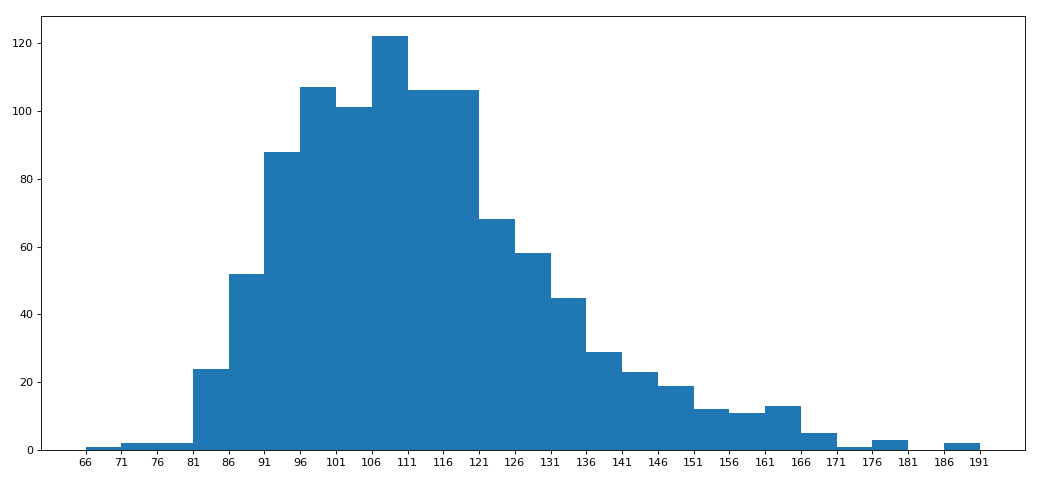
电影案例二
import pandas as pd
from matplotlib import pyplot as plt
from functools import reduce file_path = './IMDB-Movie-data.csv'
df = pd.read_csv(file_path)
# print(df.head(1))
# print(df.info()) # rating,runtime分布情况
# 选择图形:直方图
# 准备数据
# runtime_data = df['Runtime (Minutes)'].values
rate_data = df['Rating'].values
max_rate = rate_data.max()
min_rate = rate_data.min() #设置不等宽组距,hist方法中取到的会是一个左闭右开的区间[1,9,3.5)
num_bin_list = [1.9,3.5]
i = 3.5
while i<=max_rate:
i += 0.5
num_bin_list.append(i)
print(num_bin_list) #设置图形大小
plt.figure(figsize=(13,6),dpi=80)
#画直方图
plt.hist(rate_data,num_bin_list) #xticks让之前的组距能够对上
plt.xticks(num_bin_list) #显示
plt.show()

[1.9, 3.5, 4.0, 4.5, 5.0, 5.5, 6.0, 6.5, 7.0, 7.5, 8.0, 8.5, 9.0, 9.5]
五。常用统计方法
import numpy
import pandas as pd
df = pd.read_csv('IMDB-Movie-Data.csv')
print(df.info())
print(df.describe())
#获取评分的均分
rate_mean = df.Rating.mean()
print(rate_mean)
#获取导演的人数
print(df.Director.value_counts().count())
print(len(set(df.Director.tolist())))
print(len(df.Director.unique()))
#获取演员的人数
temp_actors_list = df.Actors.str.split(',').tolist()
actors_list = [i for j in temp_actors_list for i in j]
# numpy.array(temp_actors_list).flatten()
actors_num = len(set(actors_list))
print(actors_num)
<class 'pandas.core.frame.DataFrame'>
RangeIndex: 1000 entries, 0 to 999
Data columns (total 12 columns):
Rank 1000 non-null int64
Title 1000 non-null object
Genre 1000 non-null object
Description 1000 non-null object
Director 1000 non-null object
Actors 1000 non-null object
Year 1000 non-null int64
Runtime (Minutes) 1000 non-null int64
Rating 1000 non-null float64
Votes 1000 non-null int64
Revenue (Millions) 872 non-null float64
Metascore 936 non-null float64
dtypes: float64(3), int64(4), object(5)
memory usage: 93.8+ KB
None
Rank Year ... Revenue (Millions) Metascore
count 1000.000000 1000.000000 ... 872.000000 936.000000
mean 500.500000 2012.783000 ... 82.956376 58.985043
std 288.819436 3.205962 ... 103.253540 17.194757
min 1.000000 2006.000000 ... 0.000000 11.000000
25% 250.750000 2010.000000 ... 13.270000 47.000000
50% 500.500000 2014.000000 ... 47.985000 59.500000
75% 750.250000 2016.000000 ... 113.715000 72.000000
max 1000.000000 2016.000000 ... 936.630000 100.000000
[8 rows x 7 columns]
六、统计分类情况
# -*- coding: utf-8 -*- """
@Datetime: 2018/11/19
@Author: Zhang Yafei
"""
"""
对于这一组电影数据,如果我们希望统计电影分类(genre)的情况,应该如何处理数据?
思路:重新构造一个全为0的数组,列名为分类,如果某一条数据中分类出现过,就让0变为1
"""
import numpy as np
import pandas as pd
from matplotlib import pyplot as plt
from matplotlib import font_manager #中文字体
my_font = font_manager.FontProperties(family='SimHei')
#显示完整的列
pd.set_option('display.max_columns', None) df = pd.read_csv('IMDB-Movie-Data.csv')
#统计分类列表
temp_list = df.Genre.str.split(',').tolist()
genre_list = list(set([i for j in temp_list for i in j])) #构造全为0的数组
zero_df = pd.DataFrame(np.zeros((df.shape[0],len(genre_list))),columns=genre_list)
# print(zero_df)
#给每个电影出现分类的位置赋值1
for i in range(df.shape[0]):
zero_df.loc[i,temp_list[i]] = 1 # print(zero_df.head(1))
genre_count = zero_df.sum(axis=0)
print(genre_count) #排序
genre_count = genre_count.sort_values()
_x = genre_count.index
_y = genre_count.values
#画图
plt.figure(figsize=(15,6),dpi=80)
plt.bar(range(len(_x)),_y,width=0.4,color="orange")
plt.xticks(range(len(_x)),_x)
plt.title('电影分类统计图',fontproperties=my_font)
plt.show()
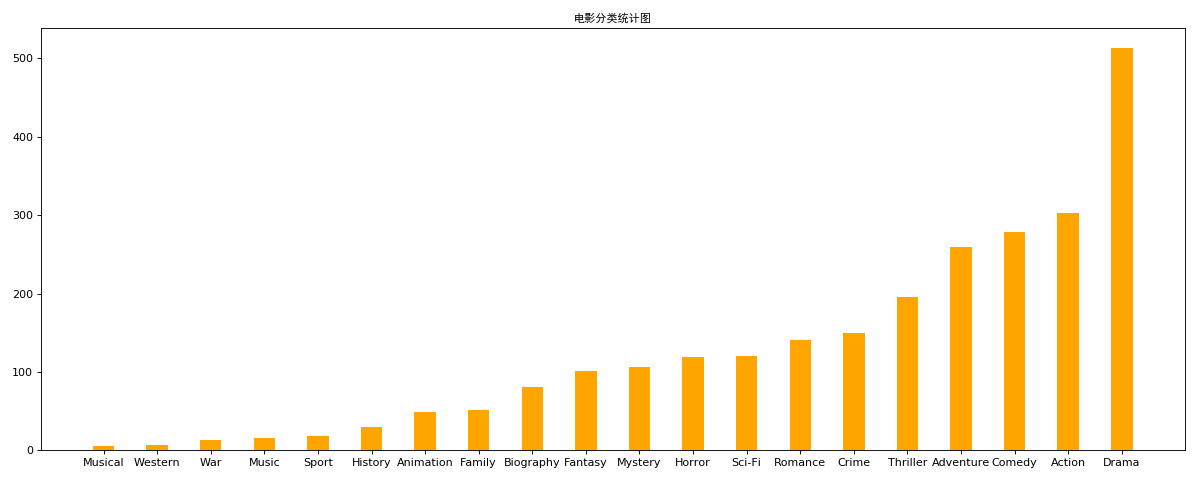
七、数据分组与聚合
# -*- coding: utf-8 -*- """
@Datetime: 2018/11/19
@Author: Zhang Yafei
"""
"""
现在我们有一组关于全球星巴克店铺的统计数据,如果我想知道美国的星巴克数量和中国的哪个多,或者我想知道中国每个省份星巴克的数量的情况,那么应该怎么办?
思路:遍历一遍,每次加1 ???
"""
import pandas as pd pd.set_option('display.max_columns', None) df = pd.read_csv('starbucks_store_worldwide.csv')
# print(df.head(1))
# print(df.info())
grouped = df.groupby(by='Country')
# print(grouped) # DataFrameGroupBy
# 可以进行遍历
# for i,j in grouped:
# print(i)
# print('-'*100)
# print(j)
# print('*'*100)
country_count = grouped['Brand'].count()
# print(country_count['US'])
# print(country_count['CN']) #统计中国每个省份店铺的数量
china_data = df[df.Country == 'CN']
china_grouped = china_data.groupby(by='State/Province').count()['Brand']
# print(china_grouped)
#数据按照多个条件进行分组
brand_grouped = df['Brand'].groupby(by=[df['Country'],df['State/Province']]).count()
# print(brand_grouped)
# print(type(brand_grouped))
#数据按照多个条件进行分组,返回dataframe
brand_grouped1 = df[['Brand']].groupby(by=[df['Country'],df['State/Province']]).count()
brand_grouped2 = df.groupby(by=[df['Country'],df['State/Province']])[['Brand']].count()
brand_grouped3 = df.groupby(by=[df['Country'],df['State/Province']]).count()[['Brand']]
# print(brand_grouped1)
# print(brand_grouped2)
# print(brand_grouped3)
#索引的方法和属性
print(brand_grouped1)
print(brand_grouped1.index)
八、分组聚合
import pandas as pd
from matplotlib import pyplot as plt pd.set_option('display.max_columns', None) df = pd.read_csv('starbucks_store_worldwide.csv') df = df.groupby(by='Country').count()['Brand'].sort_values(ascending=False)[:10] _x = df.index
_y = df.values #画图
plt.figure(figsize=(13,6),dpi=80) plt.bar(_x,_y) plt.show()
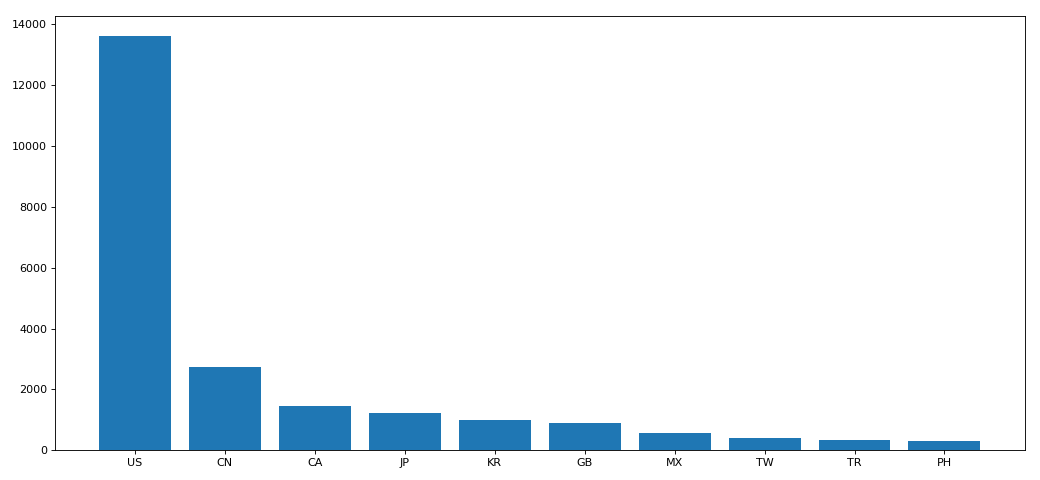
分组聚合二
import pandas as pd
from matplotlib import pyplot as plt
from matplotlib import font_manager my_font = font_manager.FontProperties(family='SimHei') pd.set_option('display.max_columns', None) df = pd.read_csv('starbucks_store_worldwide.csv')
df = df[df['Country']=='CN']
print(df.head(1)) df = df.groupby(by='City').count()['Brand'].sort_values(ascending=False)[:25] _x = df.index
_y = df.values #画图
plt.figure(figsize=(13,6),dpi=80) # plt.bar(_x,_y,width=0.3,color='orange')
plt.barh(_x,_y,height=0.3,color='orange') # plt.xticks(_x,fontproperties=my_font)
plt.yticks(_x,fontproperties=my_font) plt.show()
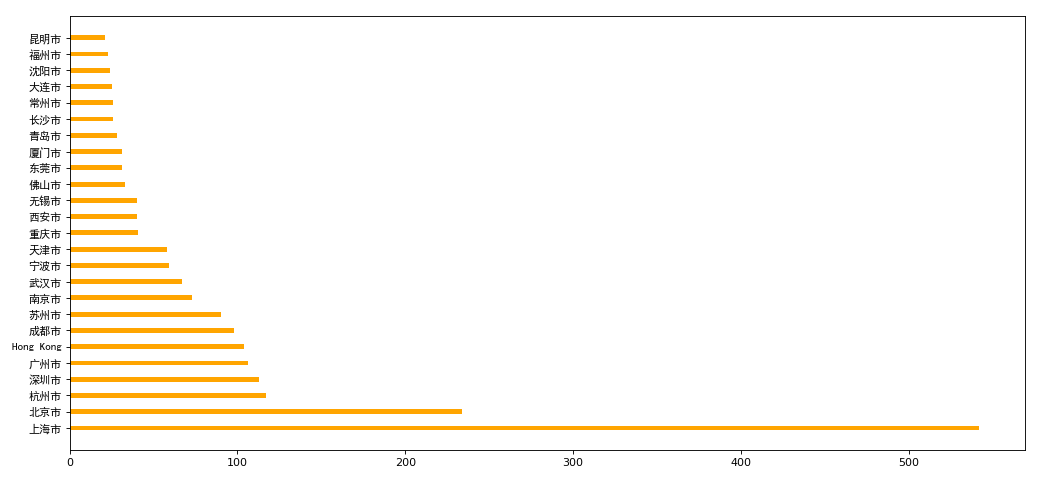
九、book_data
import pandas as pd
from matplotlib import pyplot as plt pd.set_option('display.max_columns', None) df = pd.read_csv('books.csv')
# print(df.info())
data = df[pd.notnull(df['original_publication_year'])]
grouped = data.groupby(by='original_publication_year').count()['title']
# print(grouped) grouped1 = data.average_rating.groupby(by=data['original_publication_year']).mean()
# print(grouped1) _x = grouped1.index
_y = grouped1.values plt.figure(figsize=(15,6),dpi=80)
plt.plot(range(len(_x)),_y)
plt.xticks(range(len(_x))[::10],_x[::10].astype(int),rotation=45)
plt.show()
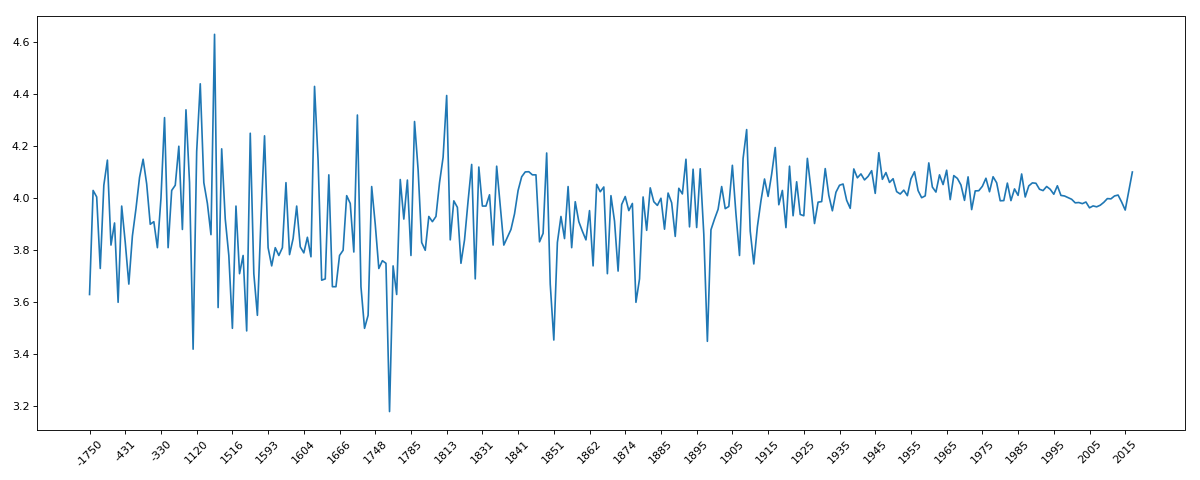
十、911data
import pandas as pd
from matplotlib import pyplot as plt
import numpy as np pd.set_option('display.max_columns',None) df = pd.read_csv('911.csv')
# print(df.head(1))
# print(df.info()) #获取分类
temp_list = df.title.str.split(':').tolist()
cate_list = list(set([i[0] for i in temp_list]))
# print(cate_list) #构造全为0的数组
zeros_df = pd.DataFrame(np.zeros((df.shape[0],len(cate_list))),columns=cate_list) #赋值
for cate in cate_list:
zeros_df[cate][df.title.str.contains(cate)] = 1
print(zeros_df) sum_ret = zeros_df.sum(axis=0)
print(sum_ret)
示例二
import pandas as pd
from matplotlib import pyplot as plt
import numpy as np pd.set_option('display.max_columns',None) df = pd.read_csv('911.csv')
# print(df.head(1))
# print(df.info()) #获取分类
temp_list = df.title.str.split(':').tolist()
cate_list = [i[0] for i in temp_list] df['cate'] = pd.DataFrame(np.array(cate_list).reshape(df.shape[0],1))
print(df.groupby(by='cate').count()['title'])
十一、时间序列
实例一
# -*- coding: utf-8 -*- """
@Datetime: 2018/11/19
@Author: Zhang Yafei
"""
"""
统计出911数据中不同月份电话次数的变化情况
"""
import pandas as pd
from matplotlib import pyplot as plt
import numpy as np pd.set_option('display.max_columns',None) df = pd.read_csv('911.csv')
df.drop_duplicates()
df.timeStamp = pd.to_datetime(df.timeStamp) #时间字符串转时间格式 df.set_index('timeStamp',inplace=True) #设置时间格式为索引
# print(df.head()) #统计出911数据中不同月份电话次数
count_by_month = df.resample('M').count()['title']
print(count_by_month) #画图
_x = count_by_month.index
_y = count_by_month.values plt.figure(figsize=(15,8),dpi=80) plt.plot(range(len(_x)),_y) plt.xticks(range(len(_x)),_x.strftime('%Y-%m-%d'),rotation=45) plt.show()

实例二
# -*- coding: utf-8 -*- """
@Datetime: 2018/11/19
@Author: Zhang Yafei
"""
"""
统计出911数据中不同月份不同类型的电话的次数的变化情况
"""
import pandas as pd
from matplotlib import pyplot as plt
import numpy as np pd.set_option('display.max_columns',None) df = pd.read_csv('911.csv')
#把时间字符串转化为时间类型设置为索引
df.timeStamp = pd.to_datetime(df.timeStamp) #添加列,表示分类
temp_list = df.title.str.split(':').tolist()
cate_list = [i[0] for i in temp_list]
df['cate'] = pd.DataFrame(np.array(cate_list).reshape(df.shape[0],1)) df.set_index('timeStamp',inplace=True) plt.figure(figsize=(15, 8), dpi=80) #分组
for group_name,group_data in df.groupby(by='cate'):
#对不同的分类都进行绘图
count_by_month = group_data.resample('M').count()['title']
# 画图
_x = count_by_month.index
_y = count_by_month.values
plt.plot(range(len(_x)),_y,label=group_name) plt.xticks(range(len(_x)), _x.strftime('%Y-%m-%d'), rotation=45) plt.legend(loc='best')
plt.show()
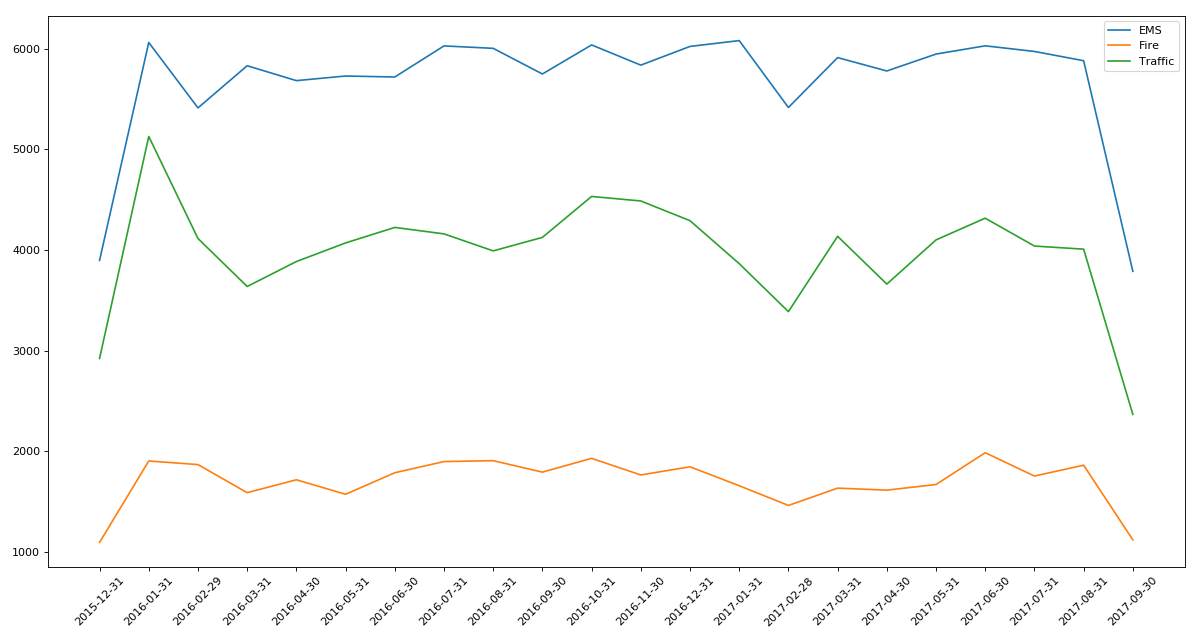
实例三:pm2.5
# -*- coding: utf-8 -*- """
@Datetime: 2018/11/19
@Author: Zhang Yafei
"""
"""
绘制美国和中国PM2.5随时间的变化情况
"""
import pandas as pd
from matplotlib import pyplot as plt pd.set_option('display.max_columns',None) df = pd.read_csv('PM2.5/BeijingPM20100101_20151231.csv')
# print(df.head()) #把分开的时间字符串通过periodIndex的方法转化为pandas的时间类型
period = pd.PeriodIndex(year=df.year,month=df.month,day=df.day,hour=df.hour,freq='H')
df['datetime'] = period
print(df.head(10)) #把datetime设置为索引
df.set_index('datetime',inplace=True) #进行降采样
df = df.resample('7D').mean() #处理缺失值,删除缺失数据
# data = df['PM_US Post'].dropna()
# china_data = df['PM_Nongzhanguan'].dropna()
data = df['PM_US Post']
china_data = df['PM_Nongzhanguan'] #画图
_x = data.index
_y = data.values _x_china = china_data.index
_y_china = china_data.values plt.figure(figsize=(13,8),dpi=80) plt.plot(range(len(_x)),_y,label='US_POST',alpha=0.7)
plt.plot(range(len(_x_china)),_y_china,label='CN_POST',alpha=0.7) plt.xticks(range(0,len(_x_china),10),list(_x_china.strftime('%Y%m%d'))[::10],rotation=45) plt.show()
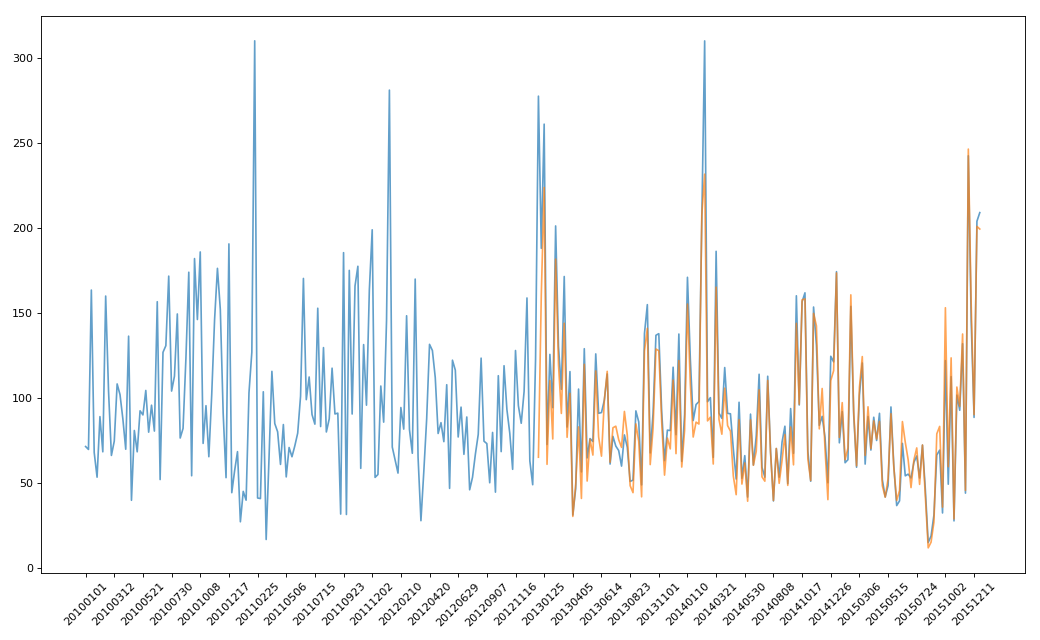
Pandas系列(十四)- 实战案例的更多相关文章
- struts2官方 中文教程 系列十四:主题Theme
介绍 当您使用一个Struts 2标签时,例如 <s:select ..../> 在您的web页面中,Struts 2框架会生成HTML,它会显示外观并控制select控件的布局.样式和 ...
- MP实战系列(十四)之分页使用
MyBatis Plus的分页,有插件式的,也有其自带了,插件需要配置,说麻烦也不是特别麻烦,不过觉得现有的MyBatis Plus足以解决,就懒得配置插件了. MyBatis Plus的资料不算是太 ...
- 闯祸了,生成环境执行了DDL操作《死磕MySQL系列 十四》
由于业务随着时间不停的改变,起初的表结构设计已经满足不了如今的需求,这时你是不是想那就加字段呗!加字段也是个艺术活,接下来由本文的主人咔咔给你吹. 试想一下这个场景 事务A在执行一个非常大的查询 事务 ...
- 学习ASP.NET Core Razor 编程系列十四——文件上传功能(二)
学习ASP.NET Core Razor 编程系列目录 学习ASP.NET Core Razor 编程系列一 学习ASP.NET Core Razor 编程系列二——添加一个实体 学习ASP.NET ...
- Netty实战十四之案例研究(一)
1.Droplr——构建移动服务 Bruno de Carvalho,首席架构师 在Droplr,我们在我的基础设施的核心部分.从我们的API服务器到辅助服务的各个部分都使用了Netty. 这是一个关 ...
- shiro实战系列(十四)之配置
Shiro 被设计成能够在任何环境下工作,从最简单的命令行应用程序到最大的的企业群集应用.由于环境的多样性,使得许多配置机制适用于它的配置. 一. 许多配置选项 Shiro的SecurityManag ...
- SpringCloud系列十四:实现容错的手段
1. 回顾 前面已用Eureka实现了微服务的注册与发现,Ribbon实现了客户端侧的负载均衡,Feign实现了声明式的API调用. 2. 实现容错的手段 如果服务提供者响应非常慢,那么消费者对提供者 ...
- WPF入门教程系列十四——依赖属性(四)
六.依赖属性回调.验证及强制值 我们通过下面的这幅图,简单介绍一下WPF属性系统对依赖属性操作的基本步骤: 借用一个常见的图例,介绍一下WPF属性系统对依赖属性操作的基本步骤: 第一步,确定Base ...
- Pandas系列(四)-文本数据处理
内容目录 1. 为什么要用str属性 2. 替换和分割 3. 提取子串 3.1 提取第一个匹配的子串 3.2 匹配所有子串 3.3 测试是否包含子串 3.4 生成哑变量 3.5 方法摘要 一.为什么要 ...
- 单点登录(十四)-----实战-----cas5.0.x登录mongodb验证方式常规的四种加密的思考和分析
我们在上一篇文章中已经讲解了cas4.2.X登录启用mongodb验证方式 单点登录(十三)-----实战-----cas4.2.X登录启用mongodb验证方式完整流程 但是密码是明文存储的,也就是 ...
随机推荐
- https协议详解
HTTPS协议建立过程 1) 客户端首次发送请求时,由于客户端(浏览器等)对一些加解密算法的支持程度不一样,但是在TLS传输中必须使用相同的加解密算法,所以在TLS握手的阶段,客户端告诉服务器端自己支 ...
- php二维数组根据某个字段去重
php的二维数组根据某个字段去重,在这默认为二维数组的结构是一样的,现在根据二维数组里的id字段去重,把id相同的重复的元素去掉 /** * 二维数组根据某个字段去重 * @param array $ ...
- C# groupby 应用小技巧
这两天感冒了,导致大脑无法有效运转,一个朋友问我,groupby 怎么给list 分组,然后再将其中一个字段组合起来,恩,觉得很简单,结果才发现,自己的脑子真的是不够用了: 恩,其实是想写其他的,但是 ...
- Elixir 简介
概述 Elixir 是一种基于 Erlang 虚拟机的函数式,面向并行的通用语言, 它是一门通用语言,所以不仅可以用在擅长的高可用,高并发场景下,也可以用在 web 开发等场景下. Erlang 诞生 ...
- 【导航】Python相关
[博客导航] Python相关导航 [索引]Python常用资源(从新手到大牛) [任务]Python语言程序设计.MOOC学习 [笔记]Python集成开发环境——PyCharm 2018.3下载. ...
- 初始数据结构(python语言)
数据结构 概念:数据结构是指相互之间存在着一种或多种关系的数据元素的集合和该集合中数据元素之间的关系组成 算法复杂度 时间复杂度 时间复杂度是同一问题可用不同算法解决,而一个算法的质量优劣将影响到算法 ...
- ThreadPoolExecutor解析
前言:在最新的阿里规范中强制使用ThreadPoolExecutor方式创建线程池,不允许使用Executors,因此有必要对ThreadPoolExecutor进行进一步了解. 1.ThreadPo ...
- 好程序员web前端分享值得参考的css理论:OOCSS、SMACSS与BEM
好程序员web前端分享值得参考的css理论:OOCSS.SMACSS与BEM 最近在The Sass Way里看到了Modular CSS typography一文,发现文章在开头部分就提到了OOCS ...
- iOS开发基础-图片切换(4)之懒加载
延续:iOS开发基础-图片切换(3),对(3)里面的代码用懒加载进行改善. 一.懒加载基本内容 懒加载(延迟加载):即在需要的时候才加载,修改属性的 getter 方法. 注意:懒加载时一定要先判断该 ...
- CentOS-常用安装
JDK安装 1.检查jdk版本:java -version 2.检查jdk安装包:rpm -qa|grep java 3.将要安装的jdk的tar.gz包拖入,CRT快捷键ALT+P 4.解压到指定目 ...
